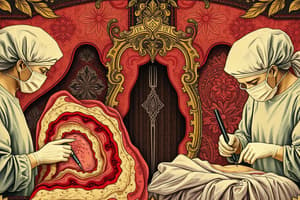Podcast
Questions and Answers
What is a superficial wound?
What is a superficial wound?
- A wound where the epidermis remains intact (correct)
- A wound that affects deeper structures
- A wound that extends through the dermis
- A wound that is fully healed
What are examples of partial-thickness wounds?
What are examples of partial-thickness wounds?
Abrasions, blisters, and skin tears
A full-thickness wound is one that extends through the dermis into deeper structures.
A full-thickness wound is one that extends through the dermis into deeper structures.
True (A)
What does stage 1 pressure ulcer staging involve?
What does stage 1 pressure ulcer staging involve?
What characterizes a stage 2 pressure ulcer?
What characterizes a stage 2 pressure ulcer?
What may be visible in a stage 3 pressure ulcer?
What may be visible in a stage 3 pressure ulcer?
In a stage 4 pressure ulcer, bone and muscle are often visible.
In a stage 4 pressure ulcer, bone and muscle are often visible.
An unstageable pressure ulcer has its base covered by _____ and/or eschar.
An unstageable pressure ulcer has its base covered by _____ and/or eschar.
What is a deep tissue injury?
What is a deep tissue injury?
Study Notes
Wound Classification
- Superficial wound: Epidermis intact; heals through inflammatory process (e.g., non-blistering sunburn).
- Partial-thickness wound: Extends through epidermis into dermis; involves abrasions, blisters, and skin tears; heals via re-epithelialization.
- Full-thickness wound: Extends through dermis into deeper structures (subcutaneous fat); depth >4mm; heals by secondary intention.
- Subcutaneous wound: Involves integumentary tissue and deeper structures (fat, muscle, tendon, bone); heals by secondary intention.
Pressure Ulcer Staging
- Stages: Categorized into Stage 1, Stage 2, Stage 3, Stage 4, Unstageable, and Deep Tissue Injury.
Stage 1 Pressure Ulcer
- Intact skin with non-blanchable redness over bony prominence; may feel firm, soft, warmer, or cooler than surrounding tissue.
- In people with dark skin, look for color difference from nearby skin areas.
Stage 2 Pressure Ulcer
- Partial-thickness tissue loss of dermis; presents as shallow open ulcer (red/pink wound bed).
- No slough present; may appear as intact or ruptured serum-filled blister, or dry/shiny ulcer without sloughing.
- Do not confuse with skin tears, tape burns, perineal dermatitis, maceration, or excoriation.
Stage 3 Pressure Ulcer
- Full-thickness tissue loss; subcutaneous fat may be visible but not bone, tendon, or muscle.
- Depth varies based on anatomical location; slough may be present but does not obscure the depth.
- May include tunneling or undermining.
Stage 4 Pressure Ulcer
- Full-thickness tissue loss; exposes bone, tendon, or muscle that is visible or palpable.
- Slough or eschar may be present; depth still visible; often includes tunneling or undermining.
- Potential for osteomyelitis as the wound can extend into fascia, tendon, or joint capsule.
Unstageable Pressure Ulcer
- Full-thickness tissue loss with the base of the ulcer covered by slough and/or eschar.
- True depth and classification undetermined until slough or eschar is removed.
Deep Tissue Injury
- Intact skin appears purple or maroon in localized area; may present with blood-filled blister.
- Caused by pressure or shear damage to underlying soft tissue; may feel painful, firm, mushy, or boggy, and can vary in temperature.
- Potential for rapid evolution; may develop thin blister over dark wound bed, progressing to eschar, exposing additional tissue layers with treatment.
Studying That Suits You
Use AI to generate personalized quizzes and flashcards to suit your learning preferences.
Description
Explore the different types of wounds, including superficial, partial-thickness, full-thickness, and subcutaneous wounds, along with their healing processes. Additionally, learn about the stages of pressure ulcers, from Stage 1 to Stage 4, including characteristics and identification strategies. This quiz will test your knowledge on these critical aspects of wound care.




